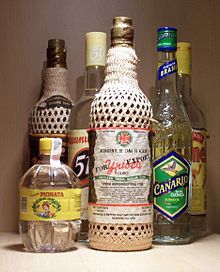Cachaça
Cachaça [ ka'ʃasa , Portuguese ka'ʃasɐ ] is a Brazilian spirit made from sugar cane juice , which used to be called aguardente , 'hot burning water' or 'fire water', and colloquially it was often referred to as pinga ' fusel ' . In Portuguese the word is feminine, but the Duden also allows the masculine grammatical gender in German , i.e. the or the Cachaça.
The legal alcohol content of cachaça in Brazil is a maximum of 48% vol. limited and must be at least 38%, products with a higher alcohol content (up to 54% vol.) must be marketed or exported as aguardente ( de cana ).
Manufacturing
In contrast to rum , cachaça is made from freshly harvested sugar cane. With rum, the raw material is mostly cane sugar molasses . "Cachaça" is a protected designation of origin in Brazil, so cachaça sold there must have been made in Brazil. Around 600 different types of sugar cane are available for production. Cachaça is either industrially or traditionally made.
First, caldo de cana 'sugar cane juice' is obtained by pressing the sugar cane , which is then diluted with water and mixed with yeast in an industrial process that ferments in stainless steel containers for around 24 hours . Traditional distilleries give the fermentation process up to 36 hours to unlock more flavors. Fermentation accelerators may be added to the sugar cane juice mash. The fermentation process in Cachaça is thus in clear contrast to that of rum and rhum artisanal. Fermentation is followed by distilling in stainless steel columns in a continuous process or, in the traditional way, discontinuously in copper stills . The traditional method claims to preserve a multitude of flavors of the raw material.
If cachaça is traditionally made - i.e. with hand-picked sugar cane, natural yeast cultures in fermentation and batchwise distilled in copper stills - the cachaça is often referred to as artesanal . The official designation as "Cachaça Artesanal" is not yet permitted in Brazil due to a lack of legal definition of binding criteria.
The industrial processing can be carried out faster and cheaper, but has the disadvantage that the taste potential of the sugar cane cannot be exhausted. That is why up to 30 grams of sugar per liter can be added to the finished distillate in Brazil. If there is more than 6 grams of sugar per liter, cachaça must then be labeled with the term adoçada 'added sugar' .
In the EU spirits regulation , cachaça does not appear as a separate category, so that cachaça is marketed in Germany under general sales names such as “Brazilian spirit”, “sugar cane brandy” or just “spirit”. This means that special restrictions such as those that apply to other spirits categories do not apply.
Cachaça can be bottled young or aged in barrels. A mature cachaça is said to have been in barrels for at least a year. 22 different types of wood can be used for this. The brownish color of some brands comes from the oak barrels in which the cachaça was stored. If the maturation takes place in barrels with a maximum capacity of 700 liters, Cachaça can be called envelhecida 'aged' .
Traditional production takes place in small distilleries whose products are rarely exported.
Regions and Brands
The regions of Bahia , Minas Gerais , Rio de Janeiro , Pernambuco and Alagoas are primarily known for the production of cachaça in Brazil . There are mostly countless smaller farms ( fazendas ) that produce sugar cane schnapps in traditional manual labor (“Cachaça artesanal”).
Most of the brands exported to Europe are, however, produced industrially, i.e. in large quantities and not according to traditional manufacturing processes. The brands Nêga Fulô, Pirassununga (Cachaça 51), Pitú , Velho Barreiro and Ypióca, which are primarily known in Germany , also belong to this variety. Traditionally produced cachaça brands such as Cachaça Magnífica are rarely found in Europe, with the Canario brand cachaça , which is distilled twice in the classic pot still process, is an exception.
The Serra das Almas is considered the first organic cachaça in Brazil.
use
- The most famous cocktail that contains cachaça is the caipirinha . Cachaça owes its great success as one of the trend spirits of the 1990s in Europe to this drink .
- A batida is also a cachaça cocktail made with various fruits or fruit juices. The best known here is the Batida de Coco .
Web links
Individual evidence
- ↑ Cachaça. Duden , accessed on August 31, 2013 .
- ↑ Philip Reim: Rum or Cachaça? The small but subtle difference. In: eyeforspirits.com. Retrieved July 6, 2016 .
- ↑ Brazilian legislation on cachaça. (PDF) Brazilian Agricultural Administration , accessed August 31, 2013 .
- ↑ Alessandro Silvestri: Adoçado - sugar added. Article from May 12, 2011 on www.cachaca-blog.de , accessed on May 13, 2011.
- ↑ Regulation (EC) No. 110/2008 of the European Parliament and of the Council of January 15, 2008 on the definition, description, presentation and labeling of spirits as well as the protection of geographical indications for spirits and the repeal of Regulation (EEC) No. 1576 / 89 . In: Official Journal of the European Union . L, No. 39, February 13, 2008, pp. 16-54.
- ↑ Unknown: Brazilian Legislation on Cachaça. Brazilian Agricultural Administration, accessed July 6, 2016 (Spanish).







